Zhangye Rainbow Mountains
Have you ever seen a multi-colored mountain? A place like this actually exists in China northwest, and that is the Rainbow Mountain in Zhangye, Gansu Province. Featuring otherworldly Danxia landform, the Rainbow Mountain was listed as a UNESCO World Heritage site since 2010. With an age of over 200 million years, the colored sandstone mountains span across over 500 square kilometers, presenting vibrant color spectrums including red, blue, green, brown and yellow. It is a jaw-dropping geological wonder that seems extremely unreal, which makes it a top photography and hiking destination of the country.
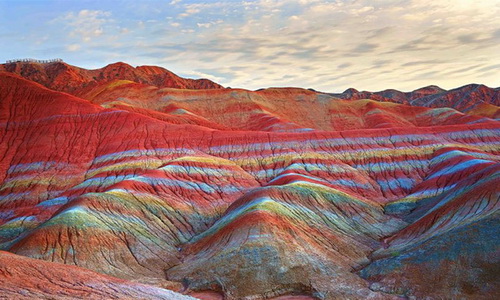
The best time of year to visit the Rainbow Mountains is the summer time from June to September, when the weather is cool and a bit moist. The sky is blue and clear, making the Rainbow Mountain showcase its full charms in natural sunlight. The most comfortable period is also the busiest season with tourist crowds. Thus you'd better book the accommodation, transportation and tickets in advance, or leave the trouble to a tour operator.
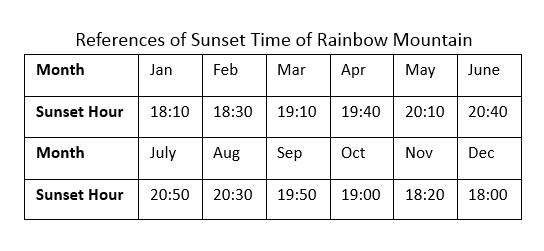
Concerning the weather, a sunny day would promise you a lot of wonderful photo chances, as you can catch the apparently changing hues of the rocks. The best time of the day to enjoy the spectacle is the sunset moment when the mountains are cladded in roseate sunglow with clear layers and strips.
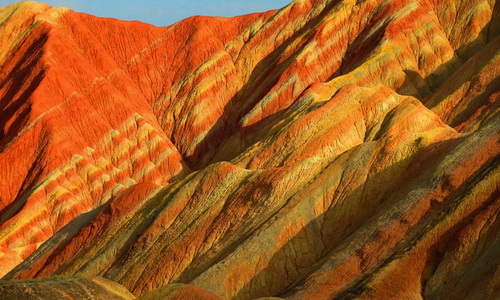
However, if it drizzles or showers, you shall take your patience to wait the rain to stop. The Rainbow Mountain is exceedingly astounding after a rain as its colors become even brighter and sharper. Seize the moment, and you would capture award-winning photographs.
The Rainbow Mountains are mainly made up of cretaceous sandstones and siltstones that were deposited deep in the earth crust. Crustal movements uplifted the mountains and formed the folded belts. The sedimentary rocks hidden below the surface of the earth before were exposed on the surface. Millions of years' water erosion and wind weathering had removed the overlying layers of continental siliciclastic rocks and revealed the underlying formations of different mineralogy and chemistry. Constant oxidation gave rise to different colors seen across the Rainbow Mountains. As a lot of irons are deposited in the sandstone, red becomes the most striking color of the rocks we see today.
Zhangye Dnaxia Landform Geopark has two major scenic areas, namely Linze and Sunan, which could be accessed by different entrances. I suggest you enter the Linze Area from the west or north gate as there are sightseeing buses leading you to four different scenic stops of viewing platforms. Sunan Area can only be accessed by self-driving tourists and involves a long walk. Therefore, you are highly recommended to enter from Linze like most travelers do.
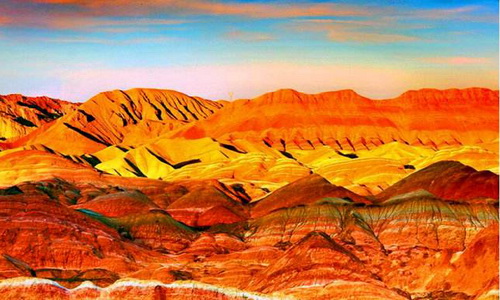
- No. 1 Viewing Platform
- No. 2 Viewing Platform
- No. 3 Viewing Platform
- No. 4 Viewing Platform
It is the largest viewing platform in the whole park made up of a cluster of decks. There are easy-to-follow steps leading to the lookouts. You could capture the amazing candy strips of the mountain, and the winding road snaking through the colored hills of all shapes and sizes from different perspectives and viewpoints.
No. 2 View Platform also has several decks, from which you could look out to different directions. The tallest deck of the whole park is here, which need to be reached by a climbing for about 20 minutes on 666 steps. On the top, you would be rewarded with superb panoramic view of the whole park with incredible terrain as far as the eye can see.
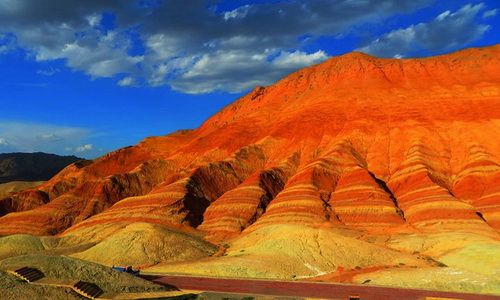
At this viewpoint, you could witness the fascinating fan-shaped mountains that showcase layers of colors like red, orange, yellow, purple, grey and white. Even the steps there were painted into multiple colors to echo with the hues of the rock formations. Here you have plenty chances to take some gorgeous photos.
The No. 4 viewing deck is the most highlighting spot of the whole park that leads to the best views. The colors of the mountains are astonishingly spectacular, much brighter than anywhere else in the park. Besides, it is the best point to shoot the sunset where you could clearly seize the subtle changing hues of yellow, reddish and light purple as the sun goes down. However, this viewpoint is also the most crowded one, so you need to reach there early before 18:00 to snap wonderful shots of the flaming rocks.
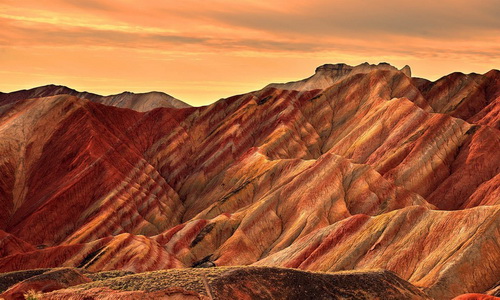
Note: The sightseeing buses run on a circulating route. The driver will make stops on every viewing platform. You have sufficient time for photography as you do not need to go back for the same bus. Once you finish one spot, hop on another bus to the next spot, but in busy season it may take more than 10 minutes waiting for the bus. The total distance linking the four spots is about 9km. Hiking lovers could choose to trek for a full circle along the driveway if the weather permits.
Zhangye is a hidden gem in deep northwest of China. There are mainly two popular ways to reach the city, by air and by rail. The speediest way is, of course, taking a plane. However, Zhangye is a small city with very limited flights operated to destinations including Lanzhou, Shanghai and Xian. Most people would take Zhangye as a stop of their Silk Road adventure by taking a high-speed train from Lanzhou that is connected to most big cities of China by air. Besides, you could also access to Zhangye by rail from Dunhuang (Mogao Caves), Jiayuguan (starting point of Chinese Great Wall), Xining (Qinghai Lake and Caka Salt Lake) and Xian (the starting point of the Silk Road).
By Bus:
From Zhangye West Coach Station, there are frequent tourist buses to the geopark, which depart about hourly from 07:30 to 17:00. The price is cheap, about RMB15 per person.
Car Rental:
It is actually the most popular travel method. After you catch the sunset scene, the public buses back to the downtown are already out of service. Therefore, you are advised to rent a car with driver who will wait for you at the exit. The cost for a round-trip is about RMB200, and it might be higher in travel peak seasons. Carpooling is a choice to lower the budget.
1. Zhangye Danxia Geological Park is completely out in the open, without any shade for travelers to escape from the exposure. Especially in summer, you are suggested to wear hats, sunglasses and use sunblock to protect yourself from the strong sunlight.
2. It can get quite chilling and windy in autumn and winter, so it is wise to wear layers to keep warm.
3. The most important advice is to wear a pair of comfortable shoes if you want to have a trek through the sand-soil path in the geopark.
4. Inside the park, there is no place for visitors to buy food, but stalls of drinks are available with much higher price. Considering several hours sightseeing, you are recommended to prepare some foods and plenty water in advance to stay hydrated.
5. Public toilets are available in all platforms of the park, but do take your own tissue.
Admission Ticket: RMB74 (including the sightseeing bus fee)
Opening Hours:
Jan. 1 - Feb. 28: 07:00-17:00
Mar. 1 - Apr. 10, Sep. 1 - Oct. 31: 06:30-18:00
Apr. 11 - Apr. 28: 06:00-18:00
Apr. 29 - Aug. 31: 05:30-19:00
Nov. 1 - Dec. 31: 07:30-17:00
Recommended Visiting Time: 3 Hours









